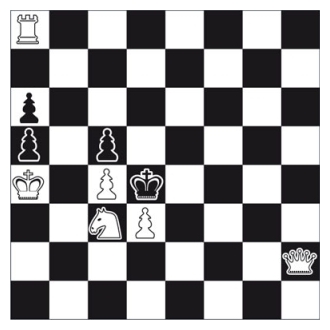Looking for bridge in the East Anglian Daily Times? Read the latest article.
Friday, 17-April-2009
I've retained an interest in chess despite not actually having played the game for years. I still subscribe to a magazine and play through games in the Guardian. Of late I've taken a bit more interest in problems and this one from Leonard Barden's column of 28-Mar didn't seem too difficult, white to move and mate in three by Vladimir Nabokov:

Have a try before reading on.
I set up the position and quickly (well, quickly for me) came across 1. Nd1! Which began a forcing sequence, K:d3 2. Qg2 then ..Kd4 3. Qd5# or ..K:c4 3. Qe4#
Now I knew that had to be 'wrong' as the Rook on a8 has no part in the game … let alone what the pawns on a5 and a6 were doing. The printed solution (1. Rh8!) bore that out. Something was wrong but at least I had the board correct.
I tried to deconstruct the problem: initial attempts, e.g. a white bishop on d1, allowed other duals (Rf8) but catering for a more simple transcription error, I settled on the pawn on a6 being misplaced – it should be on c6.
I wondered for a little longer on whether there should be a pawn on the a-file at all. The one on a5 seems to prevent Kb3 (..a4+) but I couldn't make that work. However, eventually I saw that (with the only black pawns on c6 and c5) 1. Re8! K:c3 2. Re3 Kd4 3. Qe5# and 1.. K:d3 2. Kb3! Kd4 3. Qd2/d6# – creating another dual.
I wrote to the legendary columnist and he acknowledged my analysis. I subsequently found the problem, number seven in a list of Nabokov compositions [www.chessville.com now gone, link via archive.is].

